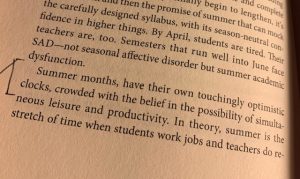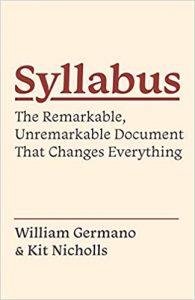I picked up Syllabus: The Remarkable, Unremarkable Document that Changes Everything by William Germano and Kit Nicholls thinking it might be a quirky little history of the course syllabus. after all, I enjoy reading other people’s syllabuses/syllabi. However, it’s really a passionate book about teaching well, using the syllabus as a framework within which to discuss how to embark with students on the joint endeavour of learning. I like its philosophy: “People learn far more by doing things than by watching others do things. If we accept that this is true, then it quickly becomes clear that a syllabus isn’t primarily a shopping list or manifest: it’s a design for student work.”
The chapters cover: how to generate energy and community in the classroom or lecture hall; how to pace the course; what reading lists are for; understanding students’ contexts, abilities and concerns; grading and giving honest feedback; and finally back to how to design the syllabus. Some of the insights and advice will be familiar to lecturers, some not so much – there are some really good ideas. I also like the way they portray designing the syllabus as a way of furthering ones own ideas; certainly in my case Markets, State and People began life as a course syllabus. I’ve always found teaching a great way to learn things myself: how can you explain anything you don’t understand yourself? How else to hear those terrific questions from enthusiastic people who haven’t yet been socialised into how they ‘ought’ to think?
The book is very nicely written too. For example, this made me laugh:
 Oh yes.
Oh yes.
One for all who value teaching.

